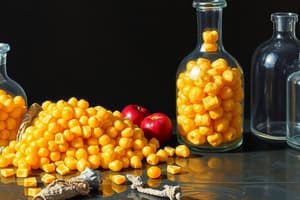Podcast
Questions and Answers
Which statement correctly characterizes the function of carbohydrates in the human body?
Which statement correctly characterizes the function of carbohydrates in the human body?
- Carbohydrates participate in the creation of nucleic acids and coenzymes. (correct)
- Carbohydrates primarily serve as insulating agents.
- Carbohydrates are only a minor energy source for cellular functions.
- Carbohydrates are used solely for protein synthesis.
What best distinguishes monosaccharides from disaccharides?
What best distinguishes monosaccharides from disaccharides?
- Monosaccharides contain two sugar units while disaccharides consist of one.
- Monosaccharides consist of single sugar units, while disaccharides consist of two linked by a glycosidic bond. (correct)
- Monosaccharides are complex sugars and disaccharides are simple sugars.
- Monosaccharides can be hydrolyzed into simpler forms, disaccharides cannot.
Which type of carbohydrate consists of 3 to 10 monosaccharide units?
Which type of carbohydrate consists of 3 to 10 monosaccharide units?
- Disaccharides
- Monosaccharides
- Polysaccharides
- Oligosaccharides (correct)
Which of the following best describes a characteristic of ketoses?
Which of the following best describes a characteristic of ketoses?
Which of the following correctly identifies a derivative of monosaccharides related to lubrication in the body?
Which of the following correctly identifies a derivative of monosaccharides related to lubrication in the body?
What distinguishes aldotrioses from ketotrioses?
What distinguishes aldotrioses from ketotrioses?
Which of the following is a characteristic of D- and L- isomers?
Which of the following is a characteristic of D- and L- isomers?
What type of monosaccharide is ribulose classified as?
What type of monosaccharide is ribulose classified as?
Which statement about epimers is correct?
Which statement about epimers is correct?
What distinguishes stereoisomers from structural isomers?
What distinguishes stereoisomers from structural isomers?
Study Notes
Carbohydrate Definition and Importance
- Carbohydrates are polyhydroxy-aldehydes, polyhydroxy-ketones, or their derivatives.
- They are organic compounds composed of carbon, hydrogen, and oxygen, also known as saccharides.
- Key functions include: primary energy source; structural and protective roles (mucopolysaccharides); lubrication (glycoproteins & proteoglycans); cell adhesion and recognition; components of glycoconjugates (glycoproteins or glycolipids); constituents of nucleic acids (DNA, RNA), coenzymes (NAD, FAD), regulatory molecules (cAMP, cGMP), and high-energy compounds (ATP, GTP).
Carbohydrate Classification
- According to the number of sugar units: monosaccharides (cannot be hydrolyzed further), disaccharides (two monosaccharides linked by a glycosidic bond), oligosaccharides (3-10 monosaccharides), and polysaccharides (more than 10 monosaccharides; can be linear or branched).
- According to the active group and number of carbon atoms: Aldoses (containing an aldehyde group) and ketoses (containing a ketone group) are categorized into trioses (3C), tetroses (4C), pentoses (5C), and hexoses (6C). Examples include glyceraldehyde (aldotriose), dihydroxyacetone (ketotriose), erythrose, ribose, glucose, galactose, mannose, and fructose.
Monosaccharide Characteristics: Physical Properties
- Stereoisomers: Molecules with the same chemical formula but different spatial arrangements. Examples include aldo-keto isomers, epimers (differing at one chiral carbon; e.g., glucose, galactose, and mannose), and enantiomers (mirror images; D and L isomers; e.g., D- and L-glyceraldehyde). D-isomers are physiologically predominant.
- Anomers (α & β): Differ in the configuration around the anomeric carbon (the carbonyl carbon in the cyclic form). α-form has the OH group down, β-form has it up.
- Optical Activity: The ability to rotate plane-polarized light; caused by asymmetric carbon atoms. All monosaccharides except dihydroxyacetone are optically active. D- and L-enantiomers rotate light in opposite directions; α and β anomers rotate in the same direction but to different degrees.
Monosaccharide Characteristics: Chemical Properties
- Reducing Character: Due to the presence of a free aldehyde or ketone group, all monosaccharides exhibit reducing properties.
- Monosaccharide Derivatives: Include amino sugars (e.g., glucosamine from glucose, replacing an OH with an amino group), deoxy sugars (e.g., 2-deoxyribose from ribose, replacing an OH with H), and sugar acids (formed by oxidation; aldonic acids, uronic acids, and saccharic acids).
- Sugar Alcohols: Formed by reduction of the aldehyde or ketone group to an alcohol group (e.g., sorbitol, mannitol).
Clinical Applications of Monosaccharide Derivatives
- Sorbitol: Artificial sweetener.
- Mannitol: Reduces intracranial pressure (treating brain edema) and acts as an osmotic diuretic.
Studying That Suits You
Use AI to generate personalized quizzes and flashcards to suit your learning preferences.
Related Documents
Description
Explore the world of carbohydrates through this quiz, covering their definition, importance, and various classifications. Understand the roles of different types of saccharides and their significance in biological systems.




